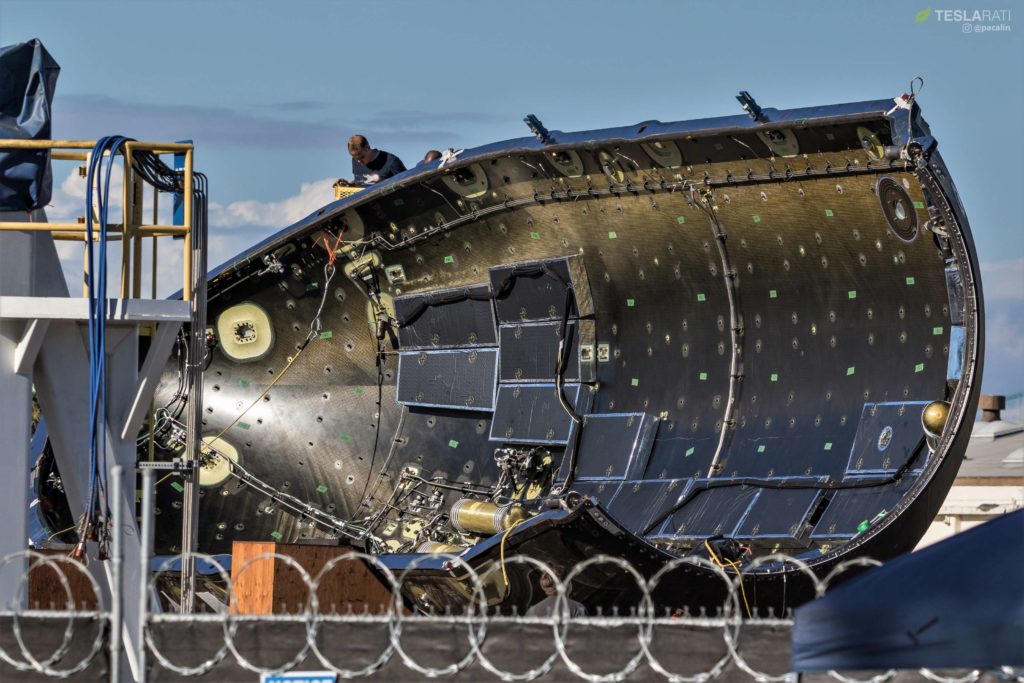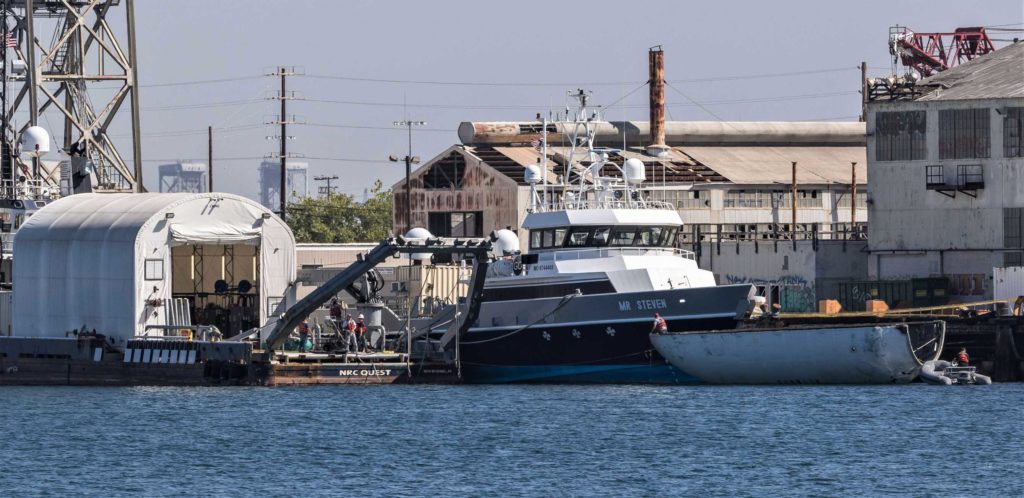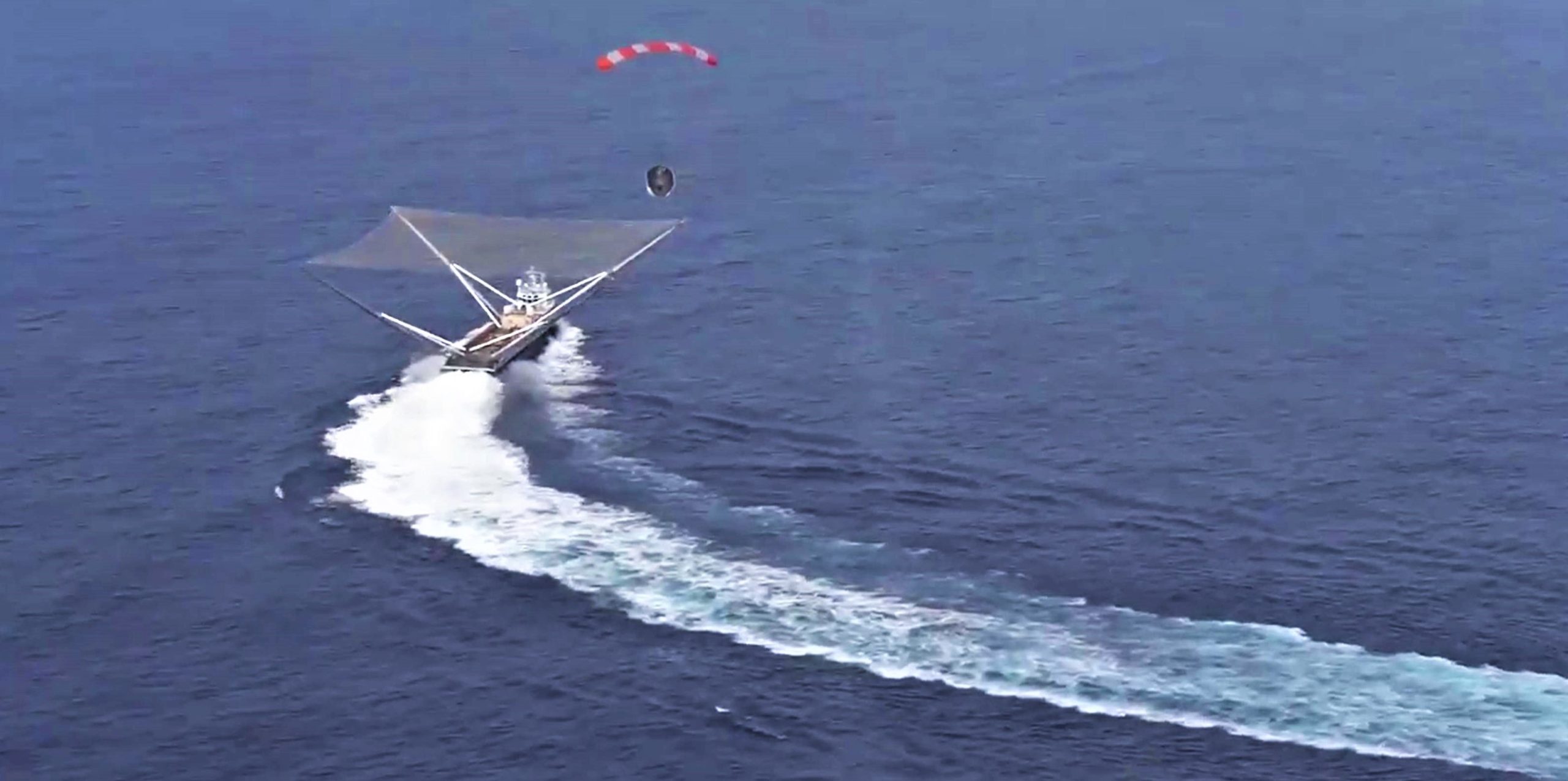
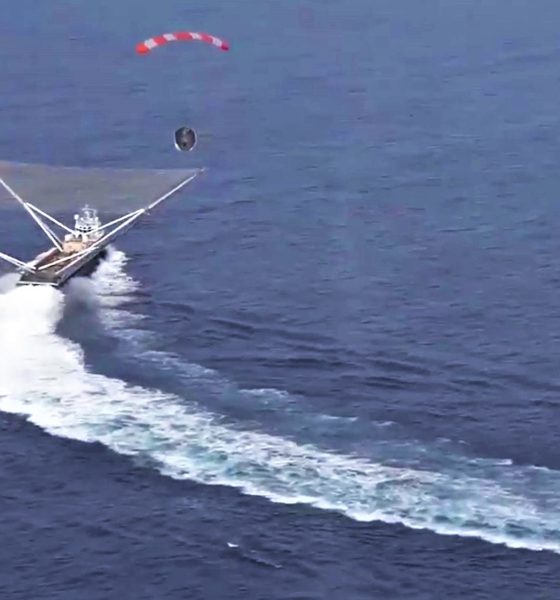
News
SpaceX reveals Falcon fairing recovery progress as Mr. Steven barely misses catch
SpaceX has offered an extraordinary glimpse into a stealthy program of Falcon fairing recovery research and development, which has utilized drop tests and iterative hardware and software upgrades to inch ever closer to fairing reuse over the last 6-9 months.
Short of a small handful of sparse comments made by executives in 2018, this is the first time SpaceX has officially acknowledged its continued attempts to optimize Falcon fairing recovery in the face of a number of missed post-launch catches. Given that the pictured fairing was so close to a successful landing that its parafoil actually became caught in Mr. Steven’s net, it seems that SpaceX has nearly solved the problems that have thus far prevented program success.
Recent fairing recovery test with Mr. Steven. So close! pic.twitter.com/DFSCfBnM0Y
— SpaceX (@SpaceX) January 8, 2019
In the last six months of 2018, SpaceX has continued to tease its slow progress towards reusable Falcon fairings, originally planned to depend on a truly bizarre solution – Mr. Steven. An impressive vessel on its own, SpaceX has gradually added and extended and upgraded a range of recovery hardware on his deck, most notably including a vast net (likely tens of thousands of square feet or 2000+ square meters) supported by four huge arms and eight supporting booms. Despite increasing the usable area of the net, SpaceX has been unable to secure an operational fairing catch since it began attempts in March 2018.
In late May 2018, SpaceX provided the best look yet at the actual process of recovering Falcon fairings, showing off the guided parafoil (a wing-like parachute) and revealing that a fairing half – launched in support of Iridium-6/GRACE-FO – had splashed down just 50 meters (~165 ft) away from Mr. Steven’s net.
Falcon 9 fairing halves deployed their parafoils and splashed down in the Pacific Ocean last week after the launch of Iridium-6/GRACE-FO. Closest half was ~50m from SpaceX’s recovery ship, Mr. Steven. https://t.co/JS7d5zTdIg pic.twitter.com/LjiTwnB4wd
— SpaceX (@SpaceX) May 31, 2018
However, in the months that followed, info about catch attempts became increasingly sparse and it eventually became clear that SpaceX was preparing to perform a range of controlled drop tests a few hundred miles off the coast of California. Ultimately, the company’s engineers and technicians hoped to use the controlled environment and a greater number of available drop/catch attempts to refine the hardware and software needed to finesse fairing halves into Mr. Steven’s net.
It may be almost absurdly large relative to any other conceivable thing that exists in the real world, but a few thousand square meters is actually more like a needle in a haystack for a piece of rocket traversing a 500-800 km arc at top speeds of more than 2 km/s.
- Mr. Steven seen after his most recent December 2018 drop and catch test. (Pauline Acalin)
- After an audible “3..2..1”, a sharp noise much like compressed gas being released was followed by a clang as the harness dropped. (Pauline Acalin)
- SpaceX’s fairing recovery fleet technicians were seen performing a bit of an unexpected ride aboard a Falcon 9 fairing half on September 19th. (Pauline Acalin)
In December 2018, following another sadly unsuccessful fairing recovery attempt on the West Coast, SpaceX CEO Elon Musk revealed that engineers were also apparently looking into backup plans in case closing that last 50-meter gap turned out to be more expensive or complicated than it was worth. Most notably, he implied that SpaceX was interested in finding ways to waterproof and ultimately refly Falcon fairings even after soft-landings in seawater, whereas fairings are already capable of reliably landing intact in the ocean but cannot be reused due to seawater contamination and cracking caused by impact.
Falcon fairing halves missed the net, but touched down softly in the water. Mr Steven is picking them up. Plan is to dry them out & launch again. Nothing wrong with a little swim.
— Elon Musk (@elonmusk) December 3, 2018
Given just how close Mr. Steven appears to be to a successful in-net fairing recovery, it now seems implausible that SpaceX will choose just one of the two options at hand, likely instead progressing both development programs to points of success. Once fairings can both be successfully waterproofed and caught in Mr. Steven’s net, SpaceX will almost certainly have itself a foolproof solution to easy and reliable recovery and reuse even in bad sea states and stormy weather.
With the company’s first launch of 2019 probably just a few days away, chances seem good that SpaceX will attempt at least one more post-launch fairing recovery with Mr. Steven. Fingers crossed!
For prompt updates, on-the-ground perspectives, and unique glimpses of SpaceX’s rocket recovery fleet check out our brand new LaunchPad and LandingZone newsletters!

News
Swedish union rep pissed that Tesla is working around a postal blockade they started
Tesla Sweden is now using dozens of private residences as a way to obtain license plates for its vehicles.

Two years into their postal blockade, Swedish unions are outraged that Tesla is still able to provide its customers’ vehicles with valid plates through various clever workarounds.
Seko chairman Gabriella Lavecchia called it “embarrassing” that the world’s largest EV maker, owned by CEO Elon Musk, refuses to simply roll over and accept the unions’ demands.
Unions shocked Tesla won’t just roll over and surrender
The postal unions’ blockade began in November 2023 when Seko and IF Metall-linked unions stopped all mail to Tesla sites to force a collective agreement. License plates for Tesla vehicles instantly became the perfect pressure point, as noted in a Dagens Arbete report.
Tesla responded by implementing initiatives to work around the blockades. A recent investigation from Arbetet revealed that Tesla Sweden is now using dozens of private residences, including one employee’s parents’ house in Trångsund and a customer-relations staffer’s home in Vårby, as a way to obtain license plates for its vehicles.
Seko chairman Gabriella Lavecchia is not pleased that Tesla Sweden is working around the unions’ efforts yet again. “It is embarrassing that one of the world’s largest car companies, owned by one of the world’s richest people, has sunk this low,” she told the outlet. “Unfortunately, it is completely frivolous that such a large company conducts business in this way.”
Two years on and plates are still being received
The Swedish Transport Agency has confirmed Tesla is still using several different workarounds to overcome the unions’ blockades.
As noted by DA, Tesla Sweden previously used different addresses to receive its license plates. At one point, the electric vehicle maker used addresses for car care shops. Tesla Sweden reportedly used this strategy in Östermalm in Stockholm, as well as in Norrköping and Gothenburg.
Another strategy that Tesla Sweden reportedly implemented involved replacement plates being ordered by private individuals when vehicles change hands from Tesla to car buyers. There have also been cases where the police have reportedly issued temporary plates to Tesla vehicles.
News
Czech Deputy excited for Tesla FSD, hints at Transport Committee review
The ANO party lawmaker shared his thoughts about FSD in a post on social media platform X.
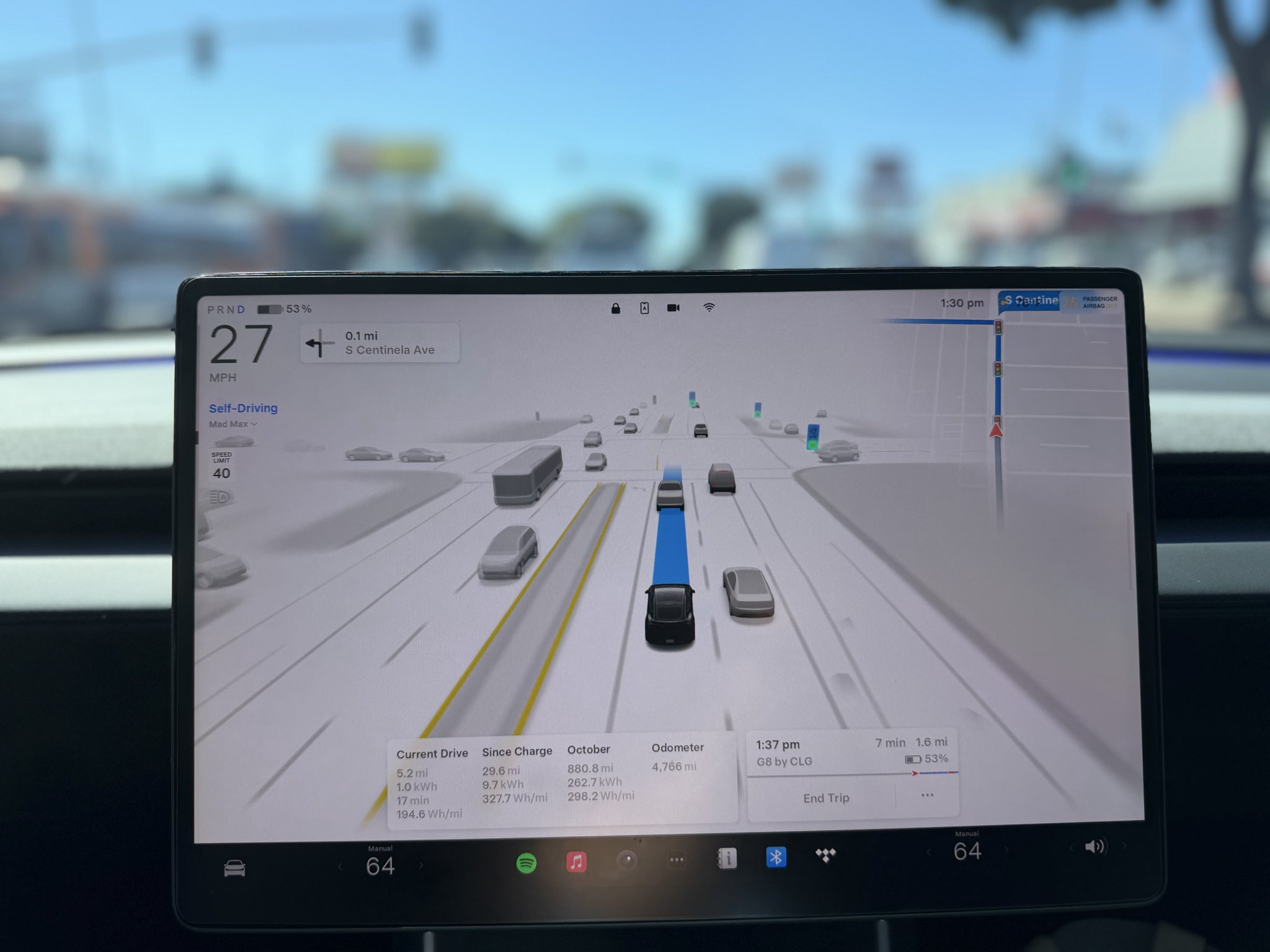
Martin Kolovratník, a Czech Republic Chamber of Deputies member, has expressed his excitement for Tesla’s Full Self-Driving (FSD) after an apparent constituent called for a quick approval for the advanced safety system.
The ANO party lawmaker, who drives both diesel and EV, shared his thoughts about the matter in a post on social media platform X.
The official’s initial statements
Kolovratník kicked off the exchange with a post outlining his coalition’s efforts to scrap highway toll exemptions for electric vehicles and plug-ins starting in 2027.
“Times have changed. Electric vehicles are no longer a fringe technology, but a full-fledged part of operations. And if someone uses the highway network, they should follow the same rules as everyone else. That’s the basis of fairness,” he wrote.
He emphasized equity over ideology, noting his personal mix of diesel and electric driving. “For this reason, there is no reason to continue favoring one technology at the expense of another… It’s not about ideology, it’s about equal conditions. That’s why we clearly agreed within the new coalition: the exemption for electric vehicles and plug-ins will end in 2027. The decision is predictable, understandable, and economically sound.”
Tesla FSD enthusiasm
The conversation pivoted to Tesla’s FSD when X user @robotinreallife, who seems to be one of the official’s constituents, replied that other matters are more important than ending highway exemptions for EVs.
“I’m happy to pay for the highway, but I have a question about a much more fundamental matter: The Netherlands will approve the operation of Tesla FSD in February 26, a technology that has been proven to reduce accidents. The Czech Republic has the option to immediately recognize this certification. Do you plan to support this step so that we don’t unnecessarily delay?” the X user asked.
Kolovratník responded promptly, sharing his own excitement for the upcoming rollout of FSD. “I know about it. I like it and it seems interesting to me. Once we set up the committees and subcommittees, we’ll open it right away in that transport one. Thanks for the tip, I’ll deliver the report,” the official noted in his reply on X.
Kolovratník’s nod to FSD hints at the system’s potentially smooth rollout to Czechia in the coming year. With the Netherlands possibly greenlighting FSD (Supervised) in early 2026, Kolovratník’s commitment could accelerate cross-border certification, boosting FSD’s foray into Europe by a notable margin.
News
Tesla Model 3 named New Zealand’s best passenger car of 2025
Tesla flipped the switch on Full Self-Driving (Supervised) in September, turning every Model 3 and Model Y into New Zealand’s most advanced production car overnight.

The refreshed Tesla Model 3 has won the DRIVEN Car Guide AA Insurance NZ Car of the Year 2025 award in the Passenger Car category, beating all traditional and electric rivals.
Judges praised the all-electric sedan’s driving dynamics, value-packed EV tech, and the game-changing addition of Full Self-Driving (Supervised) that went live in New Zealand this September.
Why the Model 3 clinched the crown
DRIVEN admitted they were late to the “Highland” party because the updated sedan arrived in New Zealand as a 2024 model, just before the new Model Y stole the headlines. Yet two things forced a re-evaluation this year.
First, experiencing the new Model Y reminded testers how many big upgrades originated in the Model 3, such as the smoother ride, quieter cabin, ventilated seats, rear touchscreen, and stalk-less minimalist interior. Second, and far more importantly, Tesla flipped the switch on Full Self-Driving (Supervised) in September, turning every Model 3 and Model Y into New Zealand’s most advanced production car overnight.
FSD changes everything for Kiwi buyers
The publication called the entry-level rear-wheel-drive version “good to drive and represents a lot of EV technology for the money,” but highlighted that FSD elevates it into another league. “Make no mistake, despite the ‘Supervised’ bit in the name that requires you to remain ready to take control, it’s autonomous and very capable in some surprisingly tricky scenarios,” the review stated.
At NZ$11,400, FSD is far from cheap, but Tesla also offers FSD (Supervised) on a $159 monthly subscription, making the tech accessible without the full upfront investment. That’s a game-changer, as it allows users to access the company’s most advanced system without forking over a huge amount of money.


